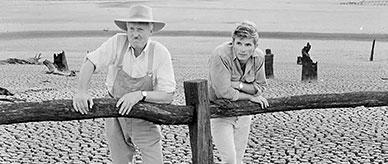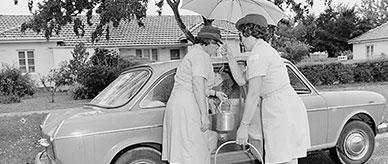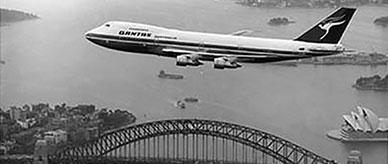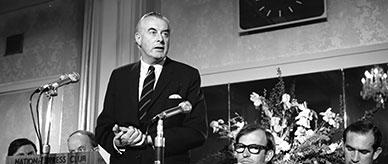
Transcript
Darwin resident: A cyclone has a sound – and it’s not merely the sound of wind or the odd thump of something hitting the house; it is perhaps the most terrifying sound forty thousand Australians have ever heard. The sound of literally millions of sheets of corrugated iron being scraped across the ground at two hundred miles an hour; the thump into rather flimsily built fibreboard buildings. And this is where the damage was caused.
I was instantly reminded – and other people have been too – of the similarity of the first shots of atom bomb attacks on the two cities in Japan. Later in the day we checked out the worst area, the devastated northern suburbs. Here, houses had literally exploded off their piers. People had been left sitting on bare floorboards or in the concrete storage sheds under the piers or, worse still, were trapped.
One big worry about Cyclone Tracy was that we felt that the people down south didn’t know that we were in trouble, that they were enjoying Christmas quite unaware that we’d been wiped out. It wasn’t until late in the afternoon we managed to get the first story through and this was by using ship’s radio and contacting Perth for the story to be sent through. It took almost four hours to establish radio contact with Perth.
Narrator: It was late on Christmas Day before the rest of the nation realised the magnitude of the disaster. The armed services responded immediately on orders from the Natural Disasters Organisation. Its chief, Major General Stretton, flew to Darwin to take charge. The Air Force began a massive airlift; the Army flew in engineers and signallers and in Sydney the Navy readied for sea. The immediate aim was to ensure that Darwin had the basic requirements for survival. Emergency supplies were taken in by air and within two days more were on the way in ten ships of the Australian Navy. The flagship Melbourne, the Stuart, Brisbane, Stalwart, Supply, Vendetta, Hobart, Flinders and the landing craft Balikpapan and Betano. The British submarine Odin also set out for Darwin for use as a floating powerhouse.
At the same time Army supplies, including medical equipment and food, were being prepared for airfreighting to Darwin.
Darwin resident: At this stage it was help yourself to whatever relief was available and this was generally done in the most responsible way. In fact the large emergency centres established at places like Casuarina High School were set up by private citizens actually entering the high schools and opening them up so that they could become refugee camps.
Dr Jim Cairns [Deputy Prime Minister]: What happened to Darwin on Christmas morning has never happened in Australia before. Darwin is devastated. Darwin is destroyed. Darwin looks like a battlefield or a Hiroshima. The people of Darwin have been magnificent through it all. To come to the aid of Darwin is our greatest national challenge for thirty years.
Narrator: The Prime Minister, Mr Whitlam, interrupted his overseas tour to visit Darwin.
Gough Whitlam: My mind inevitably went back to the early 1940s when I first saw this city, not very long after it had been bombed by the Japanese. And it’s heartbreaking to see that all the effort that’s been made over a whole generation to house people in this city has been destroyed last Christmas. Because there’s no more people can live in Darwin in present conditions than were able to live there during the war. And the people who live in Darwin now enjoy no better conditions than they did during the war. Now the great thing I have to say to the people of Darwin is that the Australian Government is determined to see that Darwin is rebuilt and restored and the citizens of Darwin are rehabilitated and returned.
Narrator: Friends and relatives waited for hours at southern airports. But before leaving on the flights south many of the refugees had waited several days for notification of their departure details. Some had only the clothes they wore. Some had left Darwin without being able to say goodbye to fathers and husbands. But at all the southern airports, as here at Adelaide, everyone tried to give them some comfort. There was an overwhelming nationwide urge to help. Appeals for food and clothing met with such a generous response that some voluntary organisations had trouble coping with it all.
[END]
About this record
This clip, from the 30-minute Australian Broadcasting Commission (ABC) television documentary The Darwin Story (1974), shows colour footage of Darwin in the aftermath of tropical Cyclone Tracy. It includes images of the total destruction of homes throughout the town, the armed forces response, makeshift refuges and the displaced local population. Arriving in Darwin, Prime Minister Gough Whitlam (1916–2014) reaffirms the government’s commitment to rebuilding Darwin and returning its population. The clip includes excerpts from news reports and a male voice-over.
Educational value
- This clip shows the extensive destruction in the aftermath of Cyclone Tracy, one of the worst natural disasters in Australian history, which devastated Darwin on Christmas Eve in 1974. The cyclone raged from just after midnight until 7 am with winds exceeding 217 kilometres per hour (unofficial estimates were as high as 300 kilometres per hour). The official death toll was 65. More than 70 per cent of housing was destroyed and most of the 48,000 residents were left homeless.
- In the clip, Whitlam compares the scale of Darwin’s devastation to that of its wartime bombing, an event within living memory for many residents. Dwellings were constructed on steel or concrete stilts and had fibrocement or weatherboard cladding. As such, many houses were blown apart by the Cyclone’s force. Stringent building codes have since been adopted nationally in cyclone-prone areas.
- The scale of the disaster required a timely and coordinated response from the Whitlam government. Under Major General Allan Stretton (1922–), all Defence Force personnel were recalled from leave, and Royal Australian Navy ships and the entire Royal Australian Air Force fleet of transport planes was used to evacuate civilians and bring in essential supplies. National emergency management protocols have since been refined from lessons learned in Darwin.
- As well as the official response to the cyclone, there was an unprecedented level of civilian support and empathy for the people of Darwin. Help came from individual volunteers and from community and humanitarian organisations such as the Red Cross and the Salvation Army. Clothing depots were set up at airports to provide for evacuees who had left with what they were wearing; information centres were established in each state; essential items were donated to the victims of the disaster by thousands nationwide; and generous donations were given.
- The devastation left most people homeless and resulted in mass civilian evacuations, largely of women and children. Nearly 25,000 people were evacuated in less than a week following the cyclone and 7234 more left by road, leaving a remaining, mostly male, population of around 10,000 in temporary accommodation. The refugee population was housed with family, friends and in other forms of temporary accommodation around the country. Many never returned.
- This clip records Whitlam's visit to cyclone-devastated Darwin and his commitment to rebuilding the city and restoring its population. Whitlam interrupted a European tour to fly to Darwin and assess the scale of devastation. He pledged 'a determined and unremitting effort to rebuild the city and relieve suffering' and the federal government established a Darwin Reconstruction Commission shortly after.
Acknowledgments
Reproduced with the permission of the Australian Broadcasting Corporation – Library Sales.
Learning resource text © Education Services Australia Limited and the National Archives of Australia 2010.
Related themes
Need help with your research?
Learn how to interpret primary sources, use our collection and more.




